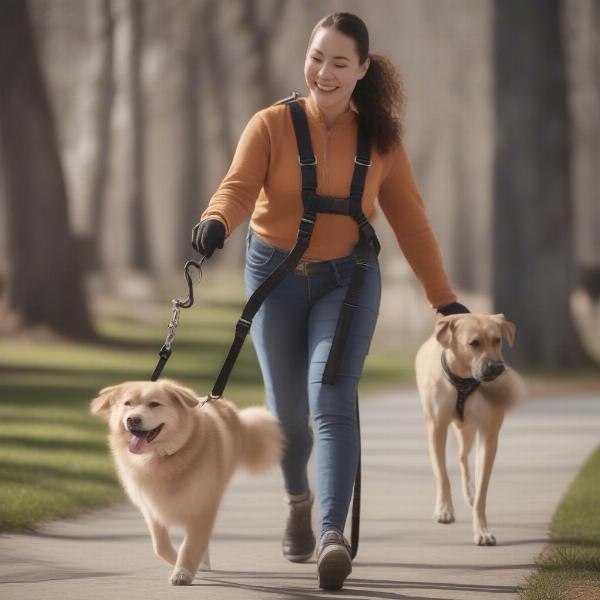A figure 8 dog harness, sometimes called a figure of 8 harness, is a popular choice for dog owners seeking more control and comfort for their furry friends. This guide explores the benefits, drawbacks, and best practices for using a figure 8 harness, helping you decide if it’s the right fit for your canine companion. We’ll cover everything from choosing the correct size to proper fitting techniques, ensuring a safe and comfortable experience for your dog.
Choosing the right figure 8 dog harness involves considering your dog’s breed, size, and activity level. While figure 8 harnesses can be beneficial for training and preventing pulling, it’s important to understand how they work and if they align with your dog’s needs.
Understanding the Figure 8 Dog Harness
The figure 8 harness gets its name from the shape it creates on the dog’s chest, resembling the number “8”. The straps cross over the chest and around the shoulders, distributing pressure evenly and reducing strain on the neck. This design makes it a popular alternative to traditional collars, especially for dogs prone to tracheal collapse or other neck injuries. However, a figure 8 harness might not be suitable for all dogs, and correct fitting is crucial.
Benefits of a Figure 8 Dog Harness
A figure 8 dog harness offers several advantages. The unique design minimizes pressure on the trachea and neck, making it a safer option than traditional collars, especially for brachycephalic breeds. The even pressure distribution also discourages pulling and can be a useful tool for training. Additionally, the snug fit of a figure 8 harness can help prevent escape, especially for dogs who are adept at slipping out of regular collars.
Drawbacks and Considerations
While figure 8 harnesses have numerous benefits, some potential drawbacks exist. Incorrectly fitted harnesses can chafe or restrict movement. They may also not be suitable for all breeds, particularly deep-chested dogs who may slip out. Furthermore, some dogs may find the feeling of restraint initially uncomfortable and require a gradual introduction to the harness.
How to Choose and Fit a Figure 8 Dog Harness
Choosing the correct size is crucial for the effectiveness and comfort of a figure 8 harness. Measure your dog’s girth and refer to the manufacturer’s size chart for the best fit. When fitting the harness, ensure it is snug but not restrictive. You should be able to fit two fingers comfortably between the straps and your dog’s body. A properly fitted harness will provide control without causing discomfort or restricting movement.
Training with a Figure 8 Dog Harness
A figure 8 harness can be a helpful tool for training, especially for dogs who pull on the leash. The design discourages pulling by gently redirecting pressure and discouraging forward motion. figure 8 dog harness When used consistently with positive reinforcement techniques, a figure 8 harness can contribute to a more enjoyable walking experience for both you and your dog.
 Dog Walking with Figure 8 Harness
Dog Walking with Figure 8 Harness
Conclusion
The figure 8 dog harness is a viable option for many dog owners seeking better control and comfort for their pets. By carefully considering the benefits and drawbacks, choosing the correct size, and implementing proper fitting techniques, you can determine if a figure 8 harness is the right choice for your furry friend. Remember, figure of 8 dog harness a well-fitted harness combined with positive reinforcement training methods can lead to more enjoyable and safer walks for everyone.
FAQ
- Is a figure 8 harness suitable for all breeds? Not necessarily. While they work well for many breeds, they may not be ideal for deep-chested dogs prone to escaping.
- Can a figure 8 harness help with pulling? Yes, the design discourages pulling by redirecting pressure and discouraging forward motion.
- How do I choose the right size figure 8 harness? Measure your dog’s girth and consult the manufacturer’s size chart.
- How tight should a figure 8 harness be? Snug enough to provide control, but not so tight that it restricts breathing or movement. You should be able to fit two fingers between the straps and your dog’s body.
- Can I use a figure 8 harness for a puppy? Yes, but ensure it’s appropriately sized and fitted, and monitor for any signs of discomfort.
- Are figure 8 harnesses better than regular collars? They can be, especially for dogs prone to tracheal collapse or neck injuries. dog collars made in usa
- What if my dog doesn’t like the figure 8 harness? Introduce it gradually and use positive reinforcement to help your dog adjust. dog leash adjustable
About ILM Dog: ILM Dog is your trusted source for expert advice on dog care and wellbeing. We offer comprehensive information on breed selection, health, training, nutrition, grooming, and much more. Whether you’re a seasoned dog owner or just starting out, figure of eight dog lead we provide valuable resources to help you navigate every aspect of dog ownership. Contact us at [email protected] or +44 20-3965-8624 for personalized guidance and support.